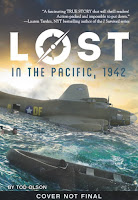Authors Tod Olson and Laura Williams McCaffrey joined us in the Children’s Room on Saturday, March 5th to discuss the intersections of fiction and nonfiction, two genres often thought—particularly by students—to be opposites of each other. On the contrary, as Tod and Laura illuminated through an exploration of their writing processes of historical nonfiction and speculative fiction/fantasy, respectively, authors of nonfiction and fiction often use similar tools when crafting their narratives. As a result, works of nonfiction can function like fiction to draw readers into a story, and fantasy can help us better understand the real world.
The Role of the Nonfiction Writer
As an author and editor of narrative nonfiction for young readers—including the How to Get Rich series and Leopold II: Butcher of the Congo—Tod noted that there isn’t a proliferation of books in that genre to begin with, and those that do exist are often packaged for parents and teachers. (Take one look at Tod’s books and you’ll see that this isn’t the case.) While readers often expect nonfiction to be a direct reproduction of what happened, Tod stressed that history writers rely on the memories of multiple storytellers—via such things as diaries, letters, and oral histories—sources that are rich but extremely unreliable, as scientific research on memory has shown. Each story changes based on whose point of view it is being told from; thus nonfiction is built on hundreds of thousands of unreliable narrators, and there are still large holes in the historical record. As Tod said, nonfiction writers transform the large ball of clay that is the historical record into a sculpture by carving out pieces and shaping what is left into story. What is important for students to understand, Tod stressed, is that there is a line between the research and the craft of writing, but that it varies from writer to writer.
Resources for Fantasy Writers
Laura laughingly commented that she feels like she has the easier job as a writer of fantasy because she doesn’t have to decide who is the hero and who is the villain of a story based on conflicting accounts, nor does she have to worry about rightness. While works of historical fantasy/science fiction/speculative fiction—such as those by Octavia Butler and Jennifer Donnelly, whose novels are set within and comment on the historical record—have more direct connections to historical nonfiction, writers of fantasy draw on similar sources in their own writing processes. Laura, who also teaches writing, and other fantasy writers often rely on historical archives as resources, which are useful even if a text isn’t historical fiction. When writing Water Shaper, historical archives helped Laura understand what existed and what interpersonal relationships were like in the medieval period. Real-world sources such as technology help writers understand social order and structure. Imaginative cultural sources like fairy tales and folklore shed light on how we understand ourselves to be—particularly in terms of what we’re scared of. Ultimately, Laura concluded, human beings and their relationship to stories are at the core of fantasy writing.
Crafting Narratives in Both Genres
Tod and Laura discussed how writers of nonfiction and fiction structure their narratives in order to make them viscerally appealing to readers. Shifting points of view to vary the story and crafting well-shaped chapters in which something important happens are two ways to do this. One of storytellers’ primary functions, as Tod explained, is to manipulate time. Writers of history can and do play fast and loose with time—making it seem as if it expands and contracts—by spending the longest portion of the narrative on the events that occurred within a smaller window of a larger story. This creates the sense for the reader of time slowing down, something we often experience in life even though, of course, time continues at its normal pace. Tod presented survival stories as a particularly appealing genre of nonfiction for younger and older readers alike because of their easily recognizable narrative progression: a catalyzing event followed by several attempts to resolve conflict and a final resolution. Stories that lack this progression, according to Tod, challenge both the writer and the reader.
Tod is currently working on a book about the Apollo 13 mission, the research for which includes working through hundreds of hours of audio tapes, as well as multiple first-hand narrative accounts from astronauts and controllers. Despite this seeming wealth of sources, Tod noted the absence of unrecorded back-room conversations. Marked, Laura’s recently released third book, is a dystopian young-adult novel featuring interspersed graphic novel vignettes. For Marked, Laura drew inspiration from a variety of sources, including fairy lore and photographs of enormous mines in National Geographic.
- Thoughts on the blurring of genre boundaries in young-adult literature from the 2012 Young Adult Literature Symposium
- Laura's interview with Cynthia Leitich Smith, in which she discusses her writing process for Water Shaper
- Jo Walton discusses subgenres of historical fantasy on Tor.com





No comments:
Post a Comment